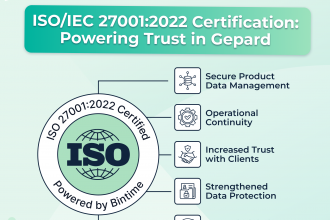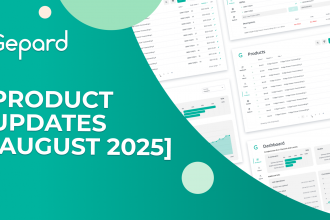Gepard PIM Product Updates July 2025: Product URL Scraping and More
Our Gepard PIM summer release emerges from a structured development cycle underpinned by thorough technical reviews and measured iteration. The result is a suite of strategic enhancements, each designed to deliver measurable business value. We begin with live product‑data scraping and conclude with a brief look at the road ahead.
1. Point, paste, scrape
Drop a product URL into Gepard, and the new Extraction AI Agent parses the page, plucks out features, and matches them to your internal taxonomy. Recognised attributes surface in a “mapped” column; anything new lands in a “suggest to create” bucket so you stay in control of data hygiene.
Business value: Content onboarding time tumbles. Instead of opening twenty‑page spec sheets, category managers can spin up a draft product in minutes and decide later whether to enrich or discard the residual attributes.
2. In‑editor AI Content Forge
Inside every product card, a discreet “Generate with AI” button now crafts descriptions, bullet points, and even “Reasons to buy” in the tone and language you choose. Unsatisfied? Regenerate a single field or the entire block; context awareness ensures outputs remain unique across locales.
Business value: No more blank pages. Marketers can move from technical data to publish‑ready storytelling without leaving the PIM, while global teams avoid copy‑paste fatigue thanks to locale‑aware uniqueness checks.
3. Export engine turned turbo
A full 82 k‑SKU portfolio that once needed a day to transform across four locales now finishes in seven hours — one run, all locales, and delta exports no longer queue behind marathon jobs.
Business value: Faster shelf updates mean fresher catalogues on‑site and fewer “why isn’t my product live yet?” tickets from sales.
4. Surgical error hunting
A dual-level filter lets you zero in on issues: choose the data block (attributes, media, logistics, etc.) and then the exact attribute to see only products failing that rule.
Business value: QA teams swap endless scrolling for targeted correction sessions, slicing time‑to‑clean‑catalogue and boosting first‑time‑right exports.
Discover Gepard PIM Capabilities for Free
5. “Few name or ID” — smarter search placeholders
Field placeholders now gently remind users they can search by internal ID as well as by name.
Business value: Less friction for power users who live in spreadsheets and know their SKUs by heart; fewer “nothing found” moments for everyone else.
6. Autotests grow up
Flaky tests were audited, fixed, and four new suites completed April‑category coverage. All seven supported categories are now protected by green, reliable pipelines.
Business value: Every deploy carries lower risk, enabling the team to ship faster without the “Friday deploy fear”.
7. GPSR compliance, on your terms
A simple toggle inside taxonomy settings injects a predefined GPSR attribute set; map them to output targets or ignore them entirely — your choice.
Business value: Brands selling into EU markets can activate safety‑compliance data in seconds, while others keep their taxonomies lean. No parallel builds, no duplicate maintenance.
8. A visual pipeline designer that scales with your ambition
The new canvas starts with an entry node, auto‑lays out branches no matter how many accounts or locales you add, and lets you deactivate whole limbs with one click.
Business value: Ops teams design complex import‑enrich‑export flows without fearing the “spaghetti graph” effect. Cleaner diagrams lead to cleaner mental models and quicker onboarding of new team‑mates.
Closing thought
None of these upgrades makes headlines on its own; together, they feel like upgrading from gravel to asphalt. Work that used to be tolerated — manual copy‑paste, overnight exports, hunting for rogue attributes — quietly disappears. The roadmap keeps moving, but for a moment, we’re enjoying the smoother ride.
Your feedback, as always, fuels the next stretch.





